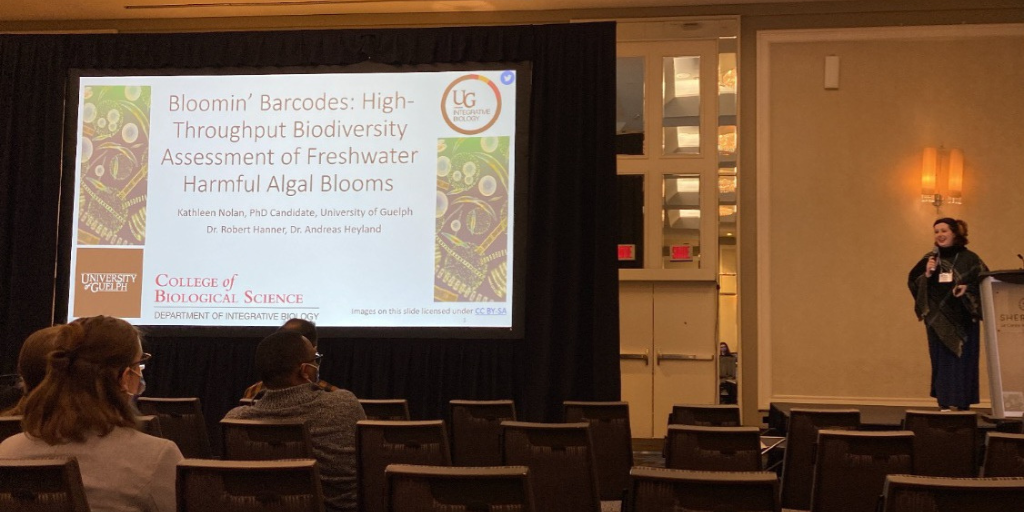Harmful algal blooms (HABs) threaten the health and sustainability of aquatic ecosystems worldwide. HABs occur when algae — simple photosynthetic organisms that live in the sea and freshwater — grow out of control. These blooms produce toxic or harmful effects on people, fish, shellfish, marine mammals, and birds. They harm the environment and impact the well-being of communities that depend on these ecosystems for various purposes. In a pioneering University of Guelph research study funded by Food from Thought, scientists have utilized DNA barcoding to investigate the microbiome associated with HABs in a small lake in Ontario.
Kathleen Nolan, a PhD candidate in the Department of Integrative Biology, is leading the research project under the co-advisory of Drs. Andreas Heyland and Robert Hanner. Nolan aims to explore the potential of DNA barcoding for identifying microalgae in freshwater ecosystems.
Challenges to Microalgae Identification
Microalgae are single-celled photosynthetic organisms abundant in aquatic ecosystems and form the basis of aquatic food webs, contributing to ecosystems’ overall health and balance. They play vital roles in marine ecosystem functioning and have numerous applications in various industries, such as nutraceuticals, pharmaceuticals, bioplastics, biofuels, agriculture, and aquaculture.
However, excessive growth of certain microalgal species can lead to HABs, causing detrimental ecological consequences such as anoxic zones, fish die-offs, toxin accumulation, and biofouling of water treatment facilities. Therefore, it is crucial to identify microalgae quickly and accurately for effective monitoring and management.
Traditionally, microalgal identification has relied on microscopy, which involves observing the morphological traits of algae under a microscope. While microscopy is a fascinating method, achieving accurate results requires significant time and expertise. Moreover, the vast diversity of microalgal species and the presence of cryptic species pose challenges to identification based solely on morphology.
Application of DNA Barcoding
DNA barcoding, a molecular identification method, offers a promising alternative to microscopy. It involves isolating, amplifying, and sequencing a specific DNA fragment from an individual organism, then comparing the sequence against a molecular database for species identification. High-throughput sequencing advancements have made DNA barcoding more accessible and cost-effective. However, the method relies on well-populated reference libraries, which are currently underdeveloped for microalgae.
“This research project addresses the gaps in microalgal DNA barcoding and aims to contribute to reference library-building efforts by generating high-quality DNA barcodes from microalgal strains,” said Nolan.
Initially, she plans to barcode professionally identified and cultured strains obtained from algal facilities. Afterwards, she intends to isolate monocultures from environmental samples using an ultra-dilution assay called SHAPE (Single cell High throughput Assessment of Phytoplankton from the Environment).
Choosing the appropriate DNA region for barcoding microalgae is another methodological challenge. Nolan plans to test eight different areas as barcode markers to determine the most effective one. So far, she has successfully barcoded microalgae using the 23S and 16S ribosomal DNA genes.
In addition to DNA barcoding, Nolan is exploring DNA metabarcoding, which involves sequencing DNA from all organisms in a mixed environmental sample.
“This method provides a whole-community snapshot, allowing for a broader understanding of microalgal biodiversity and its ecological implications. Metabarcoding data will be integrated into environmental models, enabling the interpretation of microalgal community patterns across different habitat types,” explains Nolan.
Nolan’s research progress has been promising. She has successfully isolated and barcoded microalgal strains using the SHAPE method, generating valuable sequence data. As her work continues, Nolan plans to optimize the library building protocol, further barcode microalgal strains, and delve into metabarcoding of environmental samples.
Her research will contribute to ecological monitoring, HAB detection and prevention, biotechnological advancements, and the global collection of microalgal barcodes, ultimately enhancing our understanding of microalgae and improving the condition of aquatic ecosystems.
Presentation at the SCAS Conference
The significance of this research was recognized when it was presented earlier this year at the Society for Canadian Aquatic Sciences (SCAS) conference in Montreal, Québec. The meeting served as a platform for scientists and experts to share their latest findings and discuss the challenges and opportunities associated with aquatic research including HABs. The presentation of this study highlights the importance of using techniques like DNA barcoding to advance our understanding of HABs and inform future conservation efforts.
NSERC PGS-D Award
In recognition of the significance of this research, Nolan was also recently awarded an NSERC PGS-D (Natural Sciences and Engineering Research Council of Canada Postgraduate Scholarships-Doctoral) grant. This prestigious grant supports promising scientists in pursuing advanced studies and research. The funding provided by NSERC will enable Nolan to investigate the microbiome dynamics of HABs further, enhancing our understanding of these ecological phenomena.


